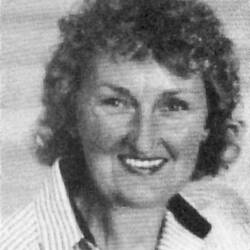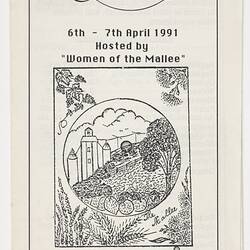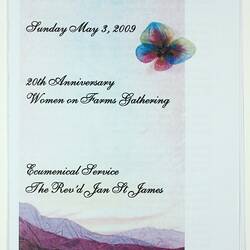Summary
Victorian Women on Farms Gathering Collection volunteer Lyn Johnson answers questions about her experience of volunteering at Museum Victoria, as well her personal connection to rural women's gatherings.
The following story and questionnaire was submitted by Lyn Johnson, a volunteer on the Victorian Women on Farms Gathering Collection.
My name is Lyn Johnson. I grew up in Newport, Victoria and attended the Newport State School and later the Williamstown High School. After working in a bank then later as secretary to the Senior Master at the Williamstown High school I spent nearly 2 years working and travelling in the UK and Europe. On my return I worked in the cataloguing Library at C.S.I.R.O. East Melbourne.
I married a dairy farmer and spent the next 35 years meeting the challenges of running a farm and family. Later I was involved, together with my husband and a partner, in establishing the Tarago River Cheese Factory in Neerim South, Gippsland. After retiring from active involvement on the farm and factory I moved to Warragul and together with my husband run a herd of beef cattle.
I was a foundation member of the Australian Women in Agriculture. I attended the first Women on Farms Gathering in Warragul held in 1990, and have attended 24 subsequent gatherings. I was on the organising committee of the Gatherings held in Warragul in 1999 and 2009.
1. How did you get involved with volunteering at Museum Victoria? Can you remember what your first day of volunteering was like?
I was already a member of the Women on Farms Gathering Heritage Group and when the formal agreement came to an end I was interested in volunteering when the opportunity arose to continue as a volunteer. My first day of volunteering commenced with an orientation meeting with volunteers coordinator Aaron Lawrence. I was given a copy of the Museum Victoria volunteer program orientation manual, a number and temporary tag. I also met with Liza Dale-Hallet, Senior Curator Sustainable Futures and Catherine McLennan, Research Associate. I was assigned the task of reviewing the completed introductions of seven of the previous gatherings.
2. What has been the highlights of working at Museum Victoria and can you tell us what sorts of things you have been working on?
Gaining an understanding of the immense amount of work that goes on behind the scenes at the Museum and the dedication of the staff who have always been friendly and encouraging. It has also been a privilege to see the vast storeroom and to be instructed on how to handle and package the Women on Farms Gathering icons. I have been working on teasing out the various strands of the ecumenical services held at each of 19 Gatherings. This has proven to be an engrossing and inspiring project.
3. What is your favourite object in the WoFG collection? Please tell us why and a little bit about it.
The icon from the 2001 North East Beechworth Gathering, the rusty spring, is my favourite object. To me it represents the flexibility women need in their daily lives as women on farms. It also symbolised the link between the past and the future; although old and rusty it still has the potential to be used, to be stretched, to recoil, and to be joined with others to achieve its purpose. I was inspired by the words of Ann Jarvis, member of the North East Gathering Committee, who wrote about the importance of the spring in the Gathering proceedings.
4. What is your favourite image in the WoFG collection?
The photo of Shirley Martin because of her vision along with others that gave rise to the first gathering. Also the pamphlet from Sea Lake as it was a simple production and represents the determination to carry on the Gatherings. The programme cover from the 2009 Warragul gathering is another favourite. This cover photo was taken from a hand-crafted screen that was used in the service. It shows a butterfly symbolising the hope of new life. This was appropriate as the Gathering was held not long after the devastating 2009 Black Saturday brushfires and a number of women from the affected areas attended the Gathering and ecumenical service.
5. Why is the history of the WoFG important? What can it tell future generations about rural Australia?
It's important because it documents the history of the Gatherings from their initial beginnings to their ongoing relevance over 20 years. It's important as it is recognised as the only collection of its kind gathered together in a museum such as this. It's important to inform future generations that communities can call upon the many skills already contained within their own rural community. The Gatherings themselves have revitalized communities, given hope to struggling communities and individuals and offered women on farms the opportunity to gain more skills and to articulate their fears, hopes, and dreams in a safe environment. Gatherings have been the impetus from which a number of women have gone on to make a contribution to agricultural industries and rural entities at a local, regional and national level.
6. How is history celebrated at the WoFG Gatherings?
From time to time Memory Sheets were/are distributed to participants. Participants were asked to record favourite memories of past Gatherings. Display cases are transported from the Museum WoFG Collection and assembled at the Gathering venue and sometimes local libraries prior to the Gathering. Display boards and flip books are also displayed. From time to time women who were involved in the early years of the Gatherings have been asked to present their recollections of past Gatherings.
More Information
-
Keywords
-
Localities
-
Authors
-
Article types






